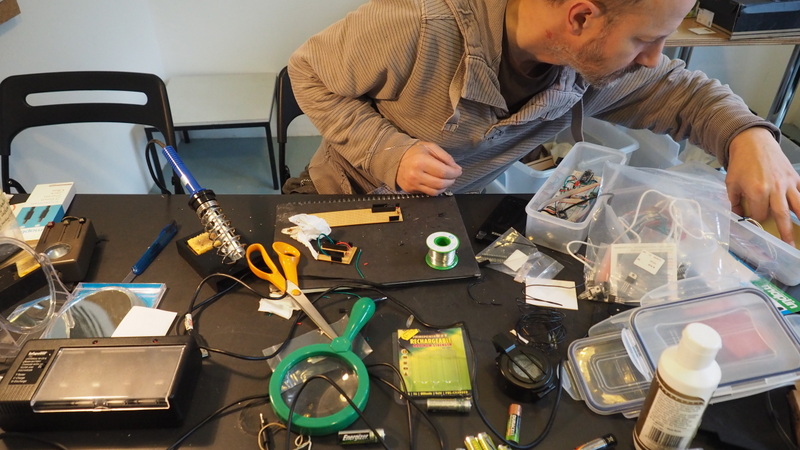We skyped with Simon de Bakker from Commonplace about how to make the camera viewfinder idea into a bespoke device. Coming across their piece Bioscope, a device that allows you to hand crank digital moving-image, encouraged me to look again at the possibility of using digital moving-image rather than paper films. I also like the way their piece Lumiere, a chandelier of light bulbs containing videos of weather systems, makes the moving-image more tangible and in-the-world.
| Simon thought the viewfinder/hollow hand idea was possible. He had ideas about how it could be done with a small lcd screen or with some kind of pepper’s ghost projection. He knew a little about the optic calculations needed and where to find advice on this. We made plans for two work days together in the Commonplace studio in Amsterdam early in 2016 to come up with a working prototype that demonstrates the idea. | Is it something you wear or something you hold up to the eye? How is the moving image is triggered – by location or by manual scrolling by the participant? Is there a way to make it possible to look through it to the real environment when no moving-image is playing? Do you crank through a sequence of images or trigger a video? |
We met a dog walker who told us that fighter pilots have visual input in one eye and one eye free.
| Lunch was in the Polish caff. We talked about each different tool and how it could be used, and which medium could be the chief means of navigation. The heartbeat pointer seems to a good fit for the route to a temporary found site in edgelands. ! simples ! Then you'd get a visual or sound payoff once you've found the site. | Tools we've got:
Possible combinations:
|
A constant conversation between Neil and I, is how the development process works. I'm all about the User Experience (the UX in developer speak) and Neil likes to think about how we can get there in achievable stages, balancing up requirements with resources.
Neil’s plan for the heartbeat pointer:
Start with core idea –
1) the heartbox takes you to a single destination while the hunter’s headphones enhance the ambient sounds (no playback of recorded sound)
2) add multiple waypoints if a specific route is important to the story
3) add a sound playback device that can be triggered by arriving at waypoints and routed through headphones. This will give a full enough experience to apply to a site and test.
4) Once the tech is stable, experiment with different qualities of haptic feedback as well as the question of having direction relate to different points of the body (like the feelspace belt).
5) Try picking up the sound of solenoid heartbeat to add to the audio
6) Try using other sounds using a waveshield to add other sounds as payoff at destination
1) the heartbox takes you to a single destination while the hunter’s headphones enhance the ambient sounds (no playback of recorded sound)
2) add multiple waypoints if a specific route is important to the story
3) add a sound playback device that can be triggered by arriving at waypoints and routed through headphones. This will give a full enough experience to apply to a site and test.
4) Once the tech is stable, experiment with different qualities of haptic feedback as well as the question of having direction relate to different points of the body (like the feelspace belt).
5) Try picking up the sound of solenoid heartbeat to add to the audio
6) Try using other sounds using a waveshield to add other sounds as payoff at destination



